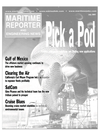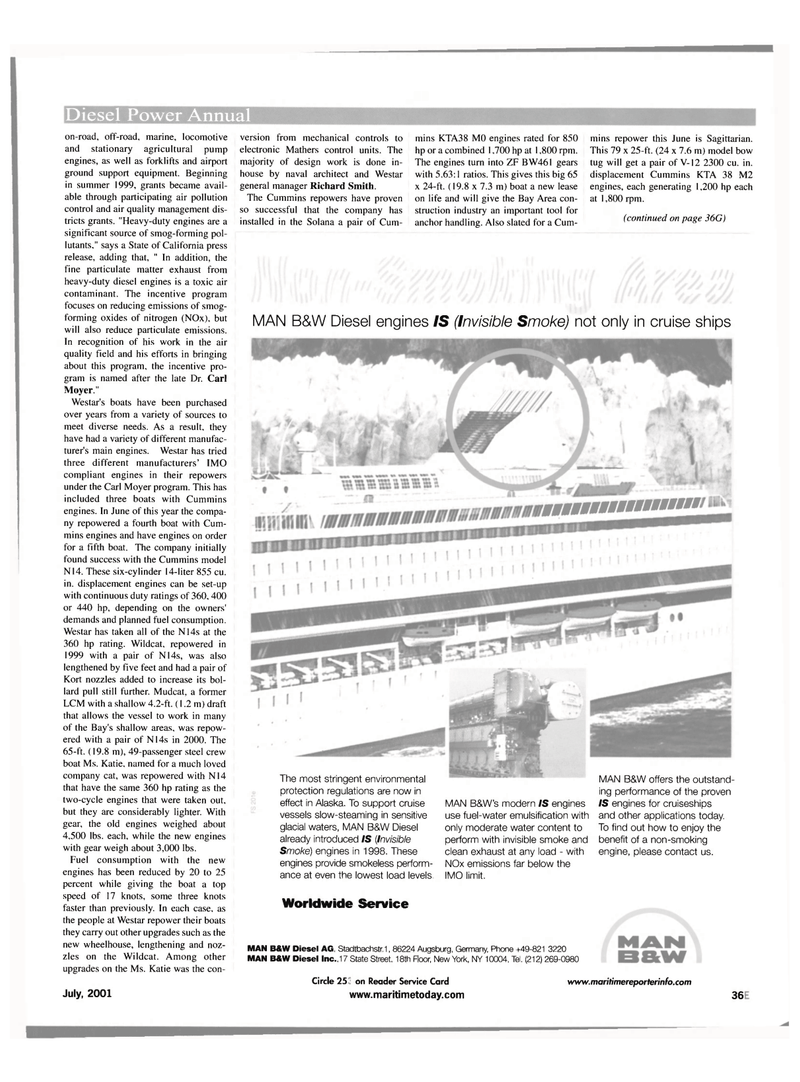
Page 41: of Maritime Reporter Magazine (July 2001)
Read this page in Pdf, Flash or Html5 edition of July 2001 Maritime Reporter Magazine
Diesel Power Annual on-road, off-road, marine, locomotive and stationary agricultural pump engines, as well as forklifts and airport ground support equipment. Beginning in summer 1999, grants became avail- able through participating air pollution control and air quality management dis- tricts grants. "Heavy-duty engines are a significant source of smog-forming pol- lutants," says a State of California press release, adding that, " In addition, the fine particulate matter exhaust from heavy-duty diesel engines is a toxic air contaminant. The incentive program focuses on reducing emissions of smog- forming oxides of nitrogen (NOx), but will also reduce particulate emissions.
In recognition of his work in the air quality field and his efforts in bringing about this program, the incentive pro- gram is named after the late Dr. Carl
Moyer.''
Westar's boats have been purchased over years from a variety of sources to meet diverse needs. As a result, they have had a variety of different manufac- turer's main engines. Westar has tried three different manufacturers' IMO compliant engines in their repowers under the Carl Moyer program. This has included three boats with Cummins engines. In June of this year the compa- ny repowered a fourth boat with Cum- mins engines and have engines on order for a fifth boat. The company initially found success with the Cummins model
N14. These six-cylinder 14-liter 855 cu. in. displacement engines can be set-up with continuous duty ratings of 360, 400 or 440 hp, depending on the owners' demands and planned fuel consumption.
Westar has taken all of the N14s at the 360 hp rating. Wildcat, repowered in 1999 with a pair of N14s, was also lengthened by five feet and had a pair of
Kort nozzles added to increase its bol- lard pull still further. Mudcat, a former
LCM with a shallow 4.2-ft. (1.2 m) draft that allows the vessel to work in many of the Bay's shallow areas, was repow- ered with a pair of N 14s in 2000. The 65-ft. (19.8 m), 49-passenger steel crew boat Ms. Katie, named for a much loved company cat, was repowered with N14 that have the same 360 hp rating as the two-cycle engines that were taken out, but they are considerably lighter. With gear, the old engines weighed about 4,500 lbs. each, while the new engines with gear weigh about 3,000 lbs.
Fuel consumption with the new engines has been reduced by 20 to 25 percent while giving the boat a top speed of 17 knots, some three knots faster than previously. In each case, as the people at Westar repower their boats they carry out other upgrades such as the new wheelhouse, lengthening and noz- zles on the Wildcat. Among other upgrades on the Ms. Katie was the con-
July, 2001 version from mechanical controls to electronic Mathers control units. The majority of design work is done in- house by naval architect and Westar general manager Richard Smith.
The Cummins repowers have proven so successful that the company has installed in the Solana a pair of Cum- mins KTA38 M0 engines rated for 850 hp or a combined 1,700 hp at 1,800 rpm.
The engines turn into ZF BW461 gears with 5.63:1 ratios. This gives this big 65 x 24-ft. (19.8 x 7.3 m) boat a new lease on life and will give the Bay Area con- struction industry an important tool for anchor handling. Also slated for a Cum- mins repower this June is Sagittarian.
This 79 x 25-ft. (24 x 7.6 m) model bow tug will get a pair of V-12 2300 cu. in. displacement Cummins KTA 38 M2 engines, each generating 1,200 hp each at 1,800 rpm. (continued on page 36G)
MAN B&W Diesel engines /S (Invisible Smoke) not only in cruise ships
Worldwide Service
MAN B&W Diesel AG, Stadtbachstr.1, 86224 Augsburg, Germany, Phone +49-821 3220
MAN B&W Diesel Inc., 17 State Street. 18th Floor, New York, NY 10004, Tel. (212) 269-0980
Circle 259 on Reader Service Card www.maritimetoday.com www.maritimereporterinfo.com 36G
The most stringent environmental protection regulations are now in effect in Alaska. To support cruise vessels slow-steaming in sensitive glacial waters, MAN B&W Diesel already introduced IS (Invisible
Smoke) engines in 1998. These engines provide smokeless perform- ance at even the lowest load levels
MAN B&W's modern IS engines use fuel-water emulsification with only moderate water content to perform with invisible smoke and clean exhaust at any load - with
NOx emissions far below the
IMO limit.
MAN B&W offers the outstand- ing performance of the proven
IS engines for cruiseships and other applications today.
To find out how to enjoy the benefit of a non-smoking engine, please contact us.

 40
40

 42
42
